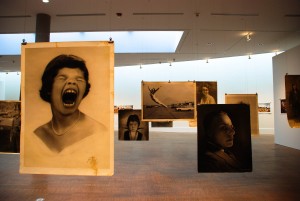By Violeta Ruiz Espigares
ruizespi@grinnell.edu
From June 24 to Sept. 4, the Faulconer Gallery hosted the works of photographer Liz Steketee.
Steketee first encountered the camera at age twelve and began studying photography in high school. She earned her degree in the same subject at the University of Michigan, where she discovered an interest for digital media. Steketee has worked as a professional photographer, as an editorial shooter and as a teacher at the San Francisco Art Institute. This is Steketee’s first exhibition as a solo artist in a museum, though the Kahmann gallery in Amsterdam recently picked up her work for display.

Steketee aims to visually accompany the viewer through the story of her life and that of her family.
“[Steketee] negotiate[s] her own way in her family with past family members or those that she knows,” said Daniel Strong, Associate Director and Curator of Exhibitions. “[She] make[s] her own art of what everybody does.”
Steketee’s portrayal of ordinary actions explores the signification behind the images through remembrance—the phantoms of the past that define our present and shape our future. Using Photoshop, collage and juxtaposition of family scenes, Steketee successfully challenges the truthfulness of her memories and her family’s history.
In the series “Family Album” and “The Panoramic Image,” Steketee mobilizes large-scale images with a soft focus and unusual framing. In processing, she transports the viewer inside the visual memory, challenges points of view and takes viewers out of their comfort zone.
In other series, like “Emma,” the artist drifts from the analysis of memories and turns to photography as art therapy. The series was shot after the premature birth of Steketee’s daughter.
“[Steketee] uses these pictures to not only understand her own family life, but also as […] a way to analyze what she went through,” Strong said.
Perhaps in an effort to lift the tone and involve the viewer, Steketee toys with exhibition norms in “Interactive Installation” and “Reconstructed Memories.” “Interactive Installation” spanned a panel to which visitors could add their own comments on the photos presented or even add their own images or words. With this activity the artist intended “to challenge the viewers’ creativity” and urge them to “reach into a new world,” according to the artist’s statement.
“Reconstructed Memories,” which held the center of the gallery space, departed in tone from the exhibition’s remaining collections. A series of black and white pictures hung from the ceiling and set a gloomier atmosphere, inviting the visitor to feel as if they were entering a moment of the past, a frozen memory drained of life. The rest of the photographs transmitted a sensation of movement and the fluid continuation of particular memories.
The second half of “Reconstructed Memories,” a reproduction of an old-fashioned living room with family portraits, carried an almost creepy ambiguity. The images and décor were clearly personal, yet the room could easily have belonged to a viewer’s parents, grandparents, or extended family. With this installation, Steketee further questioned the veracity of memory and family history.

















































